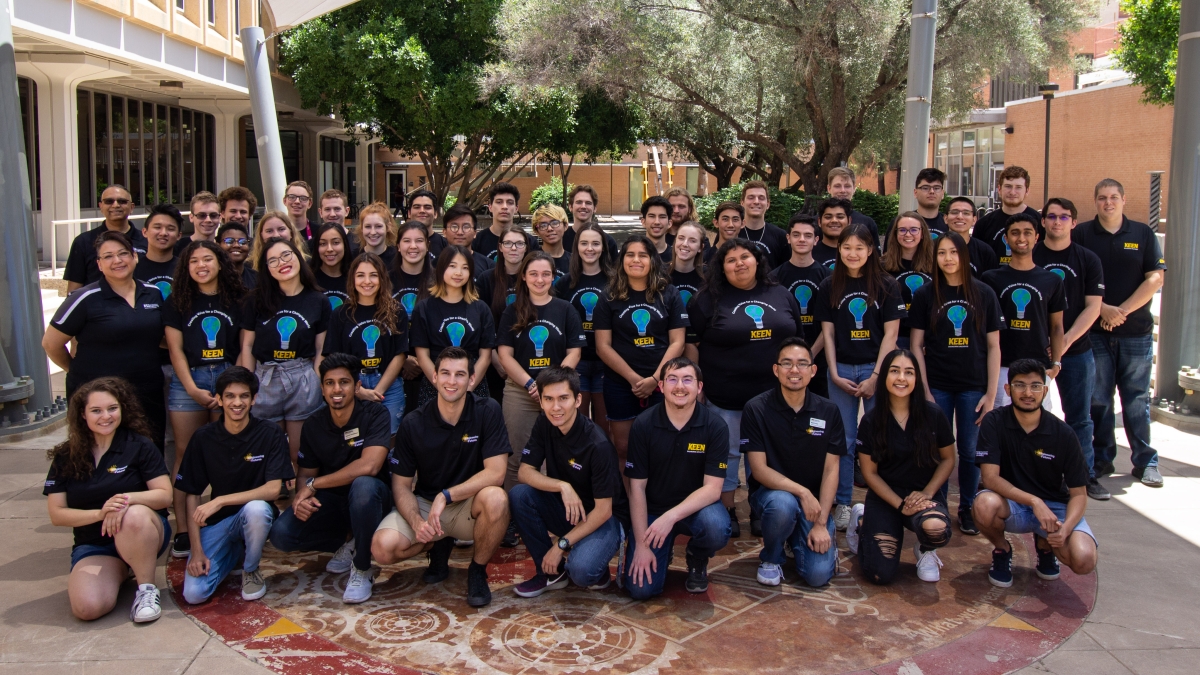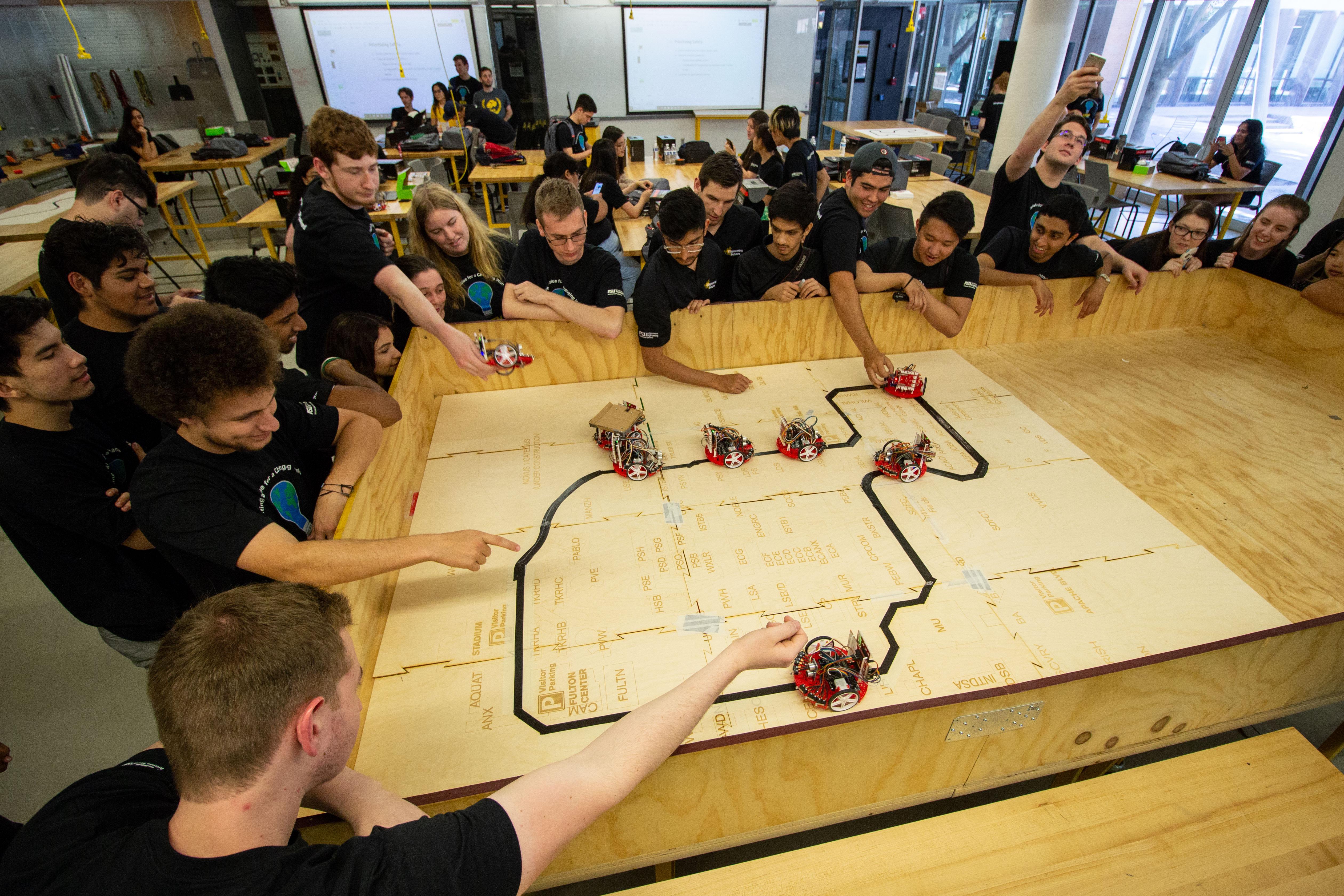ASU engineering boot camp prepares students to make societal impact

Students at the Entrepreneurial Mindset Skills Boot Camp, a weeklong residential program delivered at ASU.
How do first-year engineering students learn to create value for society while addressing industry’s rapidly evolving technology needs?
The Ira A. Fulton Schools of Engineering at Arizona State University is preparing future engineers to value entrepreneurship and make societal impacts through innovative, immersive experiences like the Engineering Futures Technology and Entrepreneurial Mindset Skills Boot Camp, a weeklong residential program delivered at ASU with the help of corporate partners.
At a recent boot camp, 41 rising sophomores learned to build, fix and adapt fully-functioning autonomous robots with guidance from professors, industry professionals and nine student mentors.
The program was created by the Engineering Futures program and the Fulton Schools of Engineering Career Center to help rising sophomores become internship-ready. All participants were awarded a $300 scholarship for their continued persistence in engineering in fall 2019.
“Our students are really eager to gain experience and get internships. That’s one of the first questions they ask at orientation,” said Robin Hammond, the founding director of the Fulton Schools Career Center.
Engineering Futures, directed by Tirupalavanam Ganesh, Tooker Professor and assistant dean of engineering education, provides a support structure to help engineering students thrive and persist to graduation. Funding from the National Science Foundation helps students develop their engineering identity, which is facilitated through experiential activities such as this boot camp.
Through a build and ideation process, student teams created an operable prototype for an autonomous food delivery system and a related business idea, which they pitched to a panel of industry professionals. And the end of the week, they made final presentations based on the feedback they had received throughout the week.
Boot camp participants also learned the value of a customer-centric design process and were challenged to articulate their newfound skills on a technical résumé and in an internship interview.

From left to right: Josephine Tang, Sarah Xi, Anfernee Tsaipi and Xochitl Roman interact with subject matter experts during the customer discovery process.
Putting new skills to work
To bring the program to life, ASU partnered with the company Texas Instruments, a strategic education partner with Engineering Futures.
Jason Rubadue, an engineer with Texas Instruments, led the build and explained the company’s willingness to support Engineering Futures.
"TI is proud to support ASU and the Engineering Futures program,” said Rubadue. “ASU is a top school and we like to hire its students. If the graduates don’t end up at TI, then we’d at least like them to be aware of and use TI when they become Engineers at other companies.”
Rubadue also has a goal to help students understand that Texas Instruments makes more than calculators, the TI is an innovative global semiconductor corporation that provides resources and tools to allow people to build robots, among many other useful technologies for society.
Texas Instruments provided each boot camp participant with a Texas Instruments Robotics System Learning Kit (TI-RSLK). Each TI-RSLK contained all the necessary components to assemble robots. Students had to learn to solder and use a crimping tool with special connectors, in addition to wiring and programming their robots after assembly.
Rubadue appreciated watching the students “get their hands dirty” and was thrilled to see the students’ joy when they persevered to get their robots to work.
“Creating something out of scratch that now has completely independent functions; that’s something really awesome,” said Sameer Channar, a rising computer science sophomore. “And testing it to see how the different iterations got better and better over time, is speaking to how we grow in ability over time.”
Jessica Dirks, another rising sophomore who is double majoring in human systems engineering and robotics, liked the collaboration required in the building and testing portion of the program.
“Because of the company of peers and being able to see how other people were thinking about it, I’ve also grown and shifted in my own mindset,” Dirks said, which helped her to troubleshoot and fix the problems with her robot.
“As they’re building the kits, they'll realize that things don't always go smoothly,” Rubadue said. “That is part of learning how to be an engineer — to solve problems as they arrive and to think of imaginative solutions.
According to Rubadue, the robotics kit is only the beginning. This is the starter kit, it is designed for future add-ons to make it a more complex system. Texas Instruments gave students the TI-RSLKs and 10 sensors for use at the boot camp and to keep so students can continue to tinker, make and innovate.
“As they move through their education, the robot will then become something that they start adding other things to,” he said, referencing possible addons like cameras or radar chips, which students might add to direct the robots where to go and enable them to be autonomous.
Employing the entrepreneurial mindset
In addition to new technical skills, students in the boot camp were introduced to a new approach to problem-solving with a customer or community in mind, called the entrepreneurial mindset. This mindset is made up of the three Cs: curiosity, connections and creating value.
Miles Mabey, student entrepreneurial catalyst with the Kern Entrepreneurial Engineering Network, describes it as “a way of going about problems that is then fueled by your technical skill set.”
KEEN is a grant-funded network of faculty members across the country who promote this kind of thinking in order to help engineering students be the best engineers they can be.
Mabey led a workshop on using the entrepreneurial mindset, in which he addressed the importance of learning who you’re designing a product for and developing pitches to better discuss complex technical matters in an easy-to-understand way.
“The pitch is a powerful communication tool,” Mabey said. “Companies look for people who can communicate their product value effectively.”
With the idea of effective communication and creative problem-solving in mind, Fulton Schools lecturer Anthony Kuhn said part of his role in the program was “making sure we’re keeping (students’) minds open to different possibilities. Just because we gave them a robot doesn’t mean every problem will be solved by a robot.”
In another portion of the boot camp, Kuhn challenged participants to use the entrepreneurial mindset to develop business models for an automated food delivery service for the ASU campus. The students were challenged to differentiate themselves from an imaginary competitor with essentially the same product.
They also had to manage input from a CEO and consider feedback from client interviews during the customer discovery portion of the program.
At the end of the week, students pitched their proposals to a panel of subject matter experts, which included a robotics and autonomous vehicles expert with a mechanical engineering background from ASU Luminosity, a regional manager from Local Motors, a traffic engineer from the city of Tempe, a data and technology analyst from the city of Gilbert and two business intelligence developers from Starbucks.

Students plan their consumer-first food delivery system at the recent engineering boot camp.
The experts shared insights on simplicity, accessibility and safety — all of these with the convenience of the consumer in mind. It’s this type of thinking that prepares students for the workplace and “gives them the confidence to launch into the next opportunity,” Hammond said.
For Hammond, who is helping prepare students for internships and professional jobs at the Fulton Schools Career Center, it’s important that the school is not only teaching students technical skills, but also enabling them to learn about themselves.
“Why do you want to be an engineer or professional in this field, and what do you want to do with it in the future?” Hammond asked. “That is a big part of your career and questions we explore — not just what you’re paid to do, but what unique attributes will you bring to the world?”
And Ganesh emphasized, “working with community and industry collaborators around our common agenda of preparing students who bring diversity of thought and experience ready to participate in a community of discoverers in engineering is the Fulton Difference.”
The goal of Engineering Futures is to open up opportunities for both personal and professional growth in the field of engineering.
This material is based upon work supported by the National Science Foundation under grant numbers 1744539 and 1834166. Any opinions, findings, and conclusions or recommendations expressed in this material are those of the author(s) and do not necessarily reflect the views of the National Science Foundation.
Written by Summer Sorg, Science & Technology Writer, Ira A. Fulton Schools of Engineering
More Science and technology

Advanced packaging the next big thing in semiconductors — and no, we're not talking about boxes
Microchips are hot. The tiny bits of silicon are integral to 21st-century life because they power the smartphones we rely on,…

Securing the wireless spectrum
The number of devices using wireless communications networks for telephone calls, texting, data and more has grown from 336…

New interactive game educates children on heat safety
Ask A Biologist, a long-running K–12 educational outreach effort by the School of Life Sciences at Arizona State University, has…